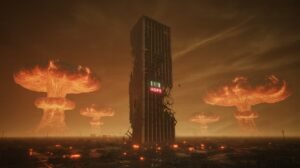
Imagine a night when the skies light up—not with fireworks, but with fireballs. When cities fall silent in seconds. When humankind stares at the edge of extinction. Here’s a chilling, step-by-step timeline of what could happen if a global nuclear war erupts.
DAY 0 – The Spark That Ignites Hell
1:00 AM: An international crisis—perhaps a border conflict or a massive cyberattack—ignites tensions between global superpowers. Diplomacy fails. Emergency meetings spiral into chaos.
2:17 AM: The first tactical nuclear weapon is launched. A limited strike targets a military base, intended as a warning. The world gasps.
3:45 AM: A retaliatory nuclear strike hits a major city. There’s no turning back now.
5:00 AM: DEFCON 1 declared. Global superpowers prepare for full nuclear deployment.
7:00 AM: Global thermonuclear war begins. Missiles hit major cities across continents.
10:00 AM: EMPs disable satellites, internet, and power grids. Humanity is thrown into darkness.
DAY 1 to 7 – Week of Fire and Ash
- Over 100 million people die within the first 24 hours.
- Firestorms destroy cities. Air becomes toxic.
- Global organizations collapse. Panic spreads worldwide.
- Radioactive fallout covers continents.
Week 2 – The Nuclear Winter Begins
- Sunlight dims by 70%.
- Temperatures drop by 10–15°C.
- Mass starvation begins as crops fail.
- Ecosystems collapse. Insects and animals die off.
Week 3–4 – Collapse of Human Order
- Governments collapse. Military rule and anarchy emerge.
- Looting, violence, and lawlessness dominate.
- Bunkers prove unsustainable. Psychological trauma spreads.
Month 2–6 – Survival of the Sickest
- Radiation sickness affects millions.
- Miscarriages and mutated births become common.
- Cannibalism and moral decay rise.
Year 1 – A New, Broken Reality
- Less than 1 billion people survive.
- No electricity, internet, or medical systems exist.
- Primitive survival becomes the new way of life.
Year 2–5 – Rise of New Powers or Chaos
- Remote regions become safe havens.
- New tribal systems form, ruled by force or resources.
- Ancient myths and superstitions resurface.
Year 10–20 – Mutations and the Unknown Future
- Mutations appear in both humans and wildlife.
- Ghost cities remain untouched, frozen in time.
- Underground survivors attempt to rebuild with selective DNA.
Year 50+ – Rewriting History
- The Earth slowly recovers—but is changed forever.
- Survivors rebuild primitive society with no memory of modern life.
- The nuclear war becomes a distant legend, a warning carved in scars.
Year 100+ – Rebirth or Extinction?
Soil, rivers, and forests are altered beyond recognition. Human life either begins anew from the ashes—or fades into extinction.
The biggest question remains: Will humanity repeat its mistakes… or learn from the ashes?
Conclusion
A global nuclear war wouldn’t just destroy cities—it would destroy the very idea of civilization. This isn’t science fiction—it’s a plausible nightmare, based on real military models and scientific research.
Peace isn’t just a goal—it’s the only real survival strategy.
Recommended Resources on Nuclear War
Wikipedia – Nuclear Holocaust
– Overview of nuclear holocaust, aftermath, and global consequences.
International Campaign to Abolish Nuclear Weapons (ICAN)
– Details on the catastrophic impact of nuclear weapons.
Bulletin of the Atomic Scientists – Nowhere to Hide
– Analysis of human survival chances during a nuclear war.
UCL News – Nuclear War and Climate Impact
– Modern research on climate aftermath from nuclear war.
American Red Cross – Nuclear Explosion & Radiation Emergency Guide
– Tips and emergency protocols for nuclear scenarios.
RAND Corporation – Global Risk: Nuclear War Report
– Risk analysis and policy solutions on nuclear war.
What If a Terrorist Group Stole a Nuclear Bomb?